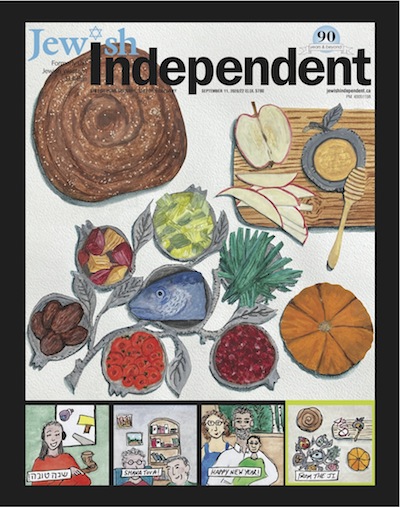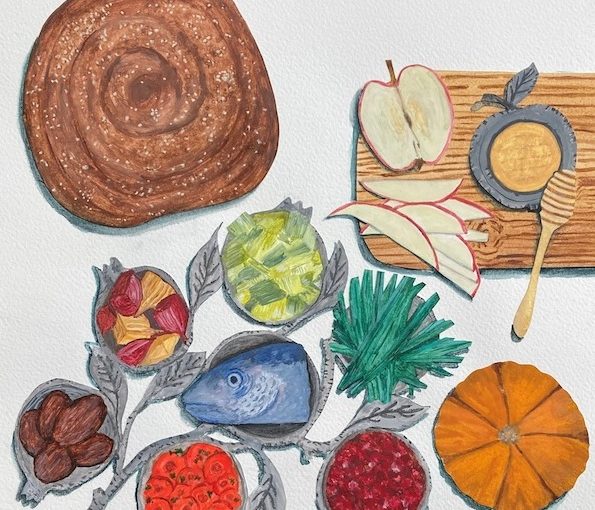I was introduced to the Sephardi and Mizrahi tradition of a Rosh Hashanah seder by a dear friend, at whose home I celebrate most of the Jewish holidays. This New Year’s, given the pandemic and that we are not in each other’s immediate bubble, I will join their seder on the first night of Rosh Hashanah either outdoors, weather permit, I was looking, perhaps, to prepare myself mentally for this year’s socially distanced gathering, and a Zoom with my family in Ontario, when I thought of the idea for the cover, which is created using watercolour and ink (and surprisingly little Photoshop).
 In a Sephardi or Mizrahi seder, special dishes are served of specific foods whose Hebrew or Aramaic names are linked in a blessing to another word that has the same root letters. Puns flourish. So, for example, the Hebrew word for carrot and that for decree have different vowels but the same root letters – gimel, zayin and resh – and the blessing over the carrots translates as, “May it be your will, Lord our God, that that our bad decrees be torn up and our merits and blessings be proclaimed.” The word for leeks, chives or scallions – karti – is akin to yikartu, cut off, so the blessing over these vegetables is, “May it be Your will, God, that our enemies be cut off.”
In a Sephardi or Mizrahi seder, special dishes are served of specific foods whose Hebrew or Aramaic names are linked in a blessing to another word that has the same root letters. Puns flourish. So, for example, the Hebrew word for carrot and that for decree have different vowels but the same root letters – gimel, zayin and resh – and the blessing over the carrots translates as, “May it be your will, Lord our God, that that our bad decrees be torn up and our merits and blessings be proclaimed.” The word for leeks, chives or scallions – karti – is akin to yikartu, cut off, so the blessing over these vegetables is, “May it be Your will, God, that our enemies be cut off.”
Spinach or beet leaves also symbolize the hope that God will make our enemies retreat and we can “beat” a way to freedom. Dates carry the hope that hatred will end; the many seeds of a pomegranate that our mitzvot will be many; an apple that we will have a sweet year; string beans that our merits will increase; a pumpkin or gourd that God will “tear” away all evil edicts against us, while our merits are proclaimed. You get the idea.
For information on the New Year’s seder, I visited, among other sites, theicenter.org/resource/hebrew-and-rosh-hashanah-seder and myjewishlearning.com/article/a-sephardic-rosh-hashanah-seder. Not being adept at puns myself, I will leave you simply with a wish for a happy, meaningful and healthy 5781.

